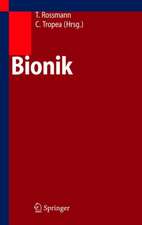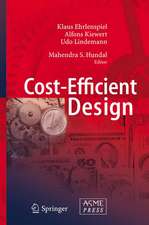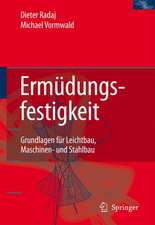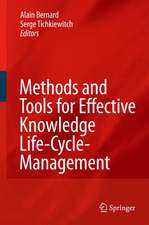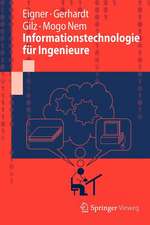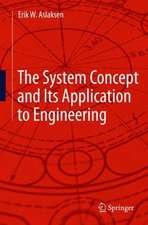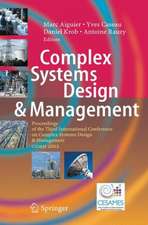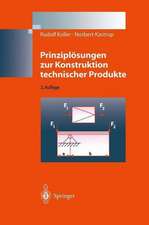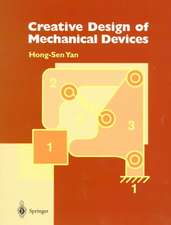Thought-Evoking Approaches in Engineering Problems
Editat de Yoshimo Itoen Limba Engleză Paperback – 30 apr 2017
The thought-evoking approach can be exemplified and typified by representative engineering problems: unveiling essential features in ‘Tangential Force Ratio and Interface Pressure’, prototype development for ‘Bio-mimetic Needle’ and application of ‘Water-jet Machining to Artificial Hip Joint’, product innovation in ‘Heat Sink for Computer’, application of ‘Graph Theory’ to similarity evaluation of production systems, leverage among reciprocity attributes in ‘Industrial and Engineering Designs for Machine Enclosure’ and academic interpretation of skills of mature technician in ‘Scraping’.
The book is intended to cultivate the multi-talented engineer of the next generation by providing them with the future perspective and ideas for challenging research and development subjects.
| Toate formatele și edițiile | Preț | Express |
|---|---|---|
| Paperback (1) | 641.03 lei 6-8 săpt. | |
| Springer International Publishing – 30 apr 2017 | 641.03 lei 6-8 săpt. | |
| Hardback (1) | 645.79 lei 6-8 săpt. | |
| Springer International Publishing – 27 mar 2014 | 645.79 lei 6-8 săpt. |
Preț: 641.03 lei
Preț vechi: 754.15 lei
-15% Nou
Puncte Express: 962
Preț estimativ în valută:
122.72€ • 128.04$ • 102.87£
122.72€ • 128.04$ • 102.87£
Carte tipărită la comandă
Livrare economică 13-27 martie
Preluare comenzi: 021 569.72.76
Specificații
ISBN-13: 9783319351940
ISBN-10: 331935194X
Pagini: 295
Ilustrații: XII, 295 p. 282 illus., 149 illus. in color.
Dimensiuni: 155 x 235 x 17 mm
Greutate: 0.44 kg
Ediția:Softcover reprint of the original 1st ed. 2014
Editura: Springer International Publishing
Colecția Springer
Locul publicării:Cham, Switzerland
ISBN-10: 331935194X
Pagini: 295
Ilustrații: XII, 295 p. 282 illus., 149 illus. in color.
Dimensiuni: 155 x 235 x 17 mm
Greutate: 0.44 kg
Ediția:Softcover reprint of the original 1st ed. 2014
Editura: Springer International Publishing
Colecția Springer
Locul publicării:Cham, Switzerland
Cuprins
1. Tangential Force Ratio and Its Applications to Industrial Technologies – Anti-vibration steel plate for refrigerator and derailment of rolling stock.- 2. In-process Measurement for Machining States – Sensing technology in noisy space.- 3. Ultrasonic Waves Method for Interface Pressure Measurement – What is Acceptable Definition of Interface Pressure.- 4. The Painless Injection Tube – From bio-mimetic technology to medical engineering.- 5. Water-jet Machining and Its Applications - Relaxation of stress concentration in cylindrical roller bearing and preferable finish of artificial joints.- 6. Heat Sinks in Computers.- 7. Noise, Vibration and Pulsation Problems in Oil Hydraulic Components and Systems.- 8. Design and Development of Construction Equipment.- 9. Remanufacturing in Machinery – Reuse and Disposal of Swarf.- 10. Similarity Evaluation for Flexible Manufacturing Cell – An Interesting Application of Graph Theory to Manufacture.- 11. Model Determination for Production Activities within Enterprise – A Challenging Trial for Virtual Concentration of Production Bases.- 12. Leverage between Industrial and Engineering Designs in Enclosure of Machine Tools.- 13. Clarification for Essential Features of Scraped Slide way by Step-land Bearing Model - Conversion of Skilled Craft to Industrial Technology.
Notă biografică
Yoshimi Ito, Dr.Eng., CEng., FIET, is professor emeritus at the Tokyo Institute of Technology and past president of the Japan Society of Mechanical Engineers. The author of numerous engineering research papers and books, he is currently a guest technical advisor at the Ministry of Foreign Affairs and is working to establish the Indian Institute of Information Technology, Design and Manufacturing.
Textul de pe ultima copertă
In creating the value-added product in not distant future, it is necessary and inevitable to establish a holistic and though-evoking approach to the engineering problem, which should be at least associated with the inter-disciplinary knowledge and thought processes across the whole engineering spheres. It is furthermore desirable to integrate it with trans-disciplinary aspects ranging from manufacturing culture, through liberal-arts engineering, and industrial sociology.
The thought-evoking approach can be exemplified and typified by representative engineering problems: unveiling essential features in ‘Tangential Force Ratio and Interface Pressure’, prototype development for ‘Bio-mimetic Needle’ and application of ‘Water-jet Machining to Artificial Hip Joint’, product innovation in ‘Heat Sink for Computer’, application of ‘Graph Theory’ to similarity evaluation of production systems, leverage among reciprocity attributes in ‘Industrial and Engineering Designs for Machine Enclosure’, and academic interpretation of skills of mature technician in ‘Scraping’.
The book is intended to cultivate the multi-talented engineer of the next generation by providing them with the future perspective and ideas for challenging research and development subjects.
The thought-evoking approach can be exemplified and typified by representative engineering problems: unveiling essential features in ‘Tangential Force Ratio and Interface Pressure’, prototype development for ‘Bio-mimetic Needle’ and application of ‘Water-jet Machining to Artificial Hip Joint’, product innovation in ‘Heat Sink for Computer’, application of ‘Graph Theory’ to similarity evaluation of production systems, leverage among reciprocity attributes in ‘Industrial and Engineering Designs for Machine Enclosure’, and academic interpretation of skills of mature technician in ‘Scraping’.
The book is intended to cultivate the multi-talented engineer of the next generation by providing them with the future perspective and ideas for challenging research and development subjects.
Caracteristici
Explores practical ways to integrate different fields to improve and inspire the design of value-added products based on specific examples of product development and application Covers a range of engineering fields including bio-mechanical, medical and liberal-arts engineering to explore different applications and requirements for each case Provides a guideline for post-graduate students and young academics about how to handle the engineering problems of the next generation Includes supplementary material: sn.pub/extras



